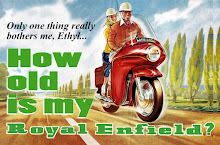 |
| A Royal Enfield Bullet just like mine. Or was it? |
I own a 1999 Royal Enfield 500cc Bullet so, on a lark the other day, I Googled around to see what other 1999 Bullets are out there.
The first thing to pop up was an eBay ad for a "1999 Enfield 500cc Bullet, Only 208 original miles." The asking price struck me as very reasonable for what must be a practically brand new 1999 Bullet! What a find.
I expected to see a stock 1999 Bullet, just like mine, perhaps dusty from years of storage. But the motorcycle was very clean — and definitely different.
The first thing I noticed was an attractive metal binnacle wrapping around the speedometer. Very nice, but obviously an aftermarket item. So, clearly, this Bullet has been modified to some degree.
 |
| Note the binnacle around the speedometer. |
I was pleased to see that a close-up photo of the speedometer shows that it is delineated in miles per hour, indicating this would likely be an original U.S. model. The odometer in the photo does, indeed, show just 208 miles.
The muffler on the motorcycle is an aftermarket item, much more attractive than the original bazooka. Not stock, but definitely an upgrade.
I ignored a couple of "Royal Enfield" insignias in places my Bullet doesn't have them — the aftermarket again? Markings on the toolbox label the motorcycle a "Bullet 500," and the rounded rear fender is correct for a 500cc Bullet. So far, it looked very familiar.
Something else that caught my eye was a curlicue in the oil line that feeds the head, with nodules, obviously meant to cool the oil. Not stock, but certainly clever, I thought.
 |
| Twisted oil line, intended to cool the motor. |
Unfortunately, the official tag on the front down tube that might have settled what year the motorcycle is appears at an angle that does not show the manufacture date ("JUN 1999" on mine).
The tag on this motorcycle is in much better shape than the faded one on mine (blasted by water and debris kicked up by the front wheel for tens of thousands of miles). Again, an indication of low miles on the for-sale bike.
I began a search for other clues. The turn signals are the same as found on my 1999; unusual, as the mounting stalks of those things disintegrate with age, so you often see aftermarket turn signals fitted on an old Bullet.
A video in the ad shows the for-sale motorcycle running, and in the video the front turn signals are indeed changed to aftermarket items.
The handlebar controls look just like the Magura items on my early 1999 — the factory changed to Minda designs mid-year, again suggesting this motorcycle is indeed a 1999.
But this is strange: the back brake pedal is on the left side of the motorcycle. Royal Enfields officially imported into the United States from 1995 on were required to have the brake on the right, as does mine.
Graham Scarth, of the Royal Enfield Owners Club (UK), helps motorcyclists determine the correct age of their Royal Enfields. He advised me that the numbers that are visible on the down-tube tag confirm that this Bullet is in fact a U.S. model.
This means that the motorcycle for sale should have its gearshift lever on the left side, if it is a U.S. model.
It doesn't. In fact, the photos in the ad show no gearshift pedal anywhere! How is this possible?
 |
| The brake lever is on the left, so there should be a gear lever here. |
As with everything else, there is a possible explanation.
To be legal, Royal Enfield Bullets meant for the U.S. in the 1990s had their gearshifts on the left thanks to a peculiar bodge: crude and sloppy linkage that transferred shift action from the gearshift pedal, on the left, to the gearbox on the right.
I've worked hard to make this bodge work fairly well on my bike.
Some owners actually went to the trouble to install kits that reversed the modification, restoring shifting to the right side in hopes of better action. Perhaps that has been done here and the gearshift lever itself is off during modification? If so, this isn't mentioned in the ad.
The ad lists "Mikuni VM32 carburetor (up from 28), high performance camshafts, improved clutch, lightweight pushrods," all from Hitchcock's Motorcycles in the UK, a high end provider.
It also states: "208 miles, still needs to be ridden suitably to attain 500 mile break in. Upgraded components installed but no miles since that installation."
Instead of a look at exactly what my Bullet would have been like 26 years ago, the ad presents a look at how this motorcycle was modified. Interesting.
At the price, I'd consider buying this Bullet — if I didn't already have one.


























